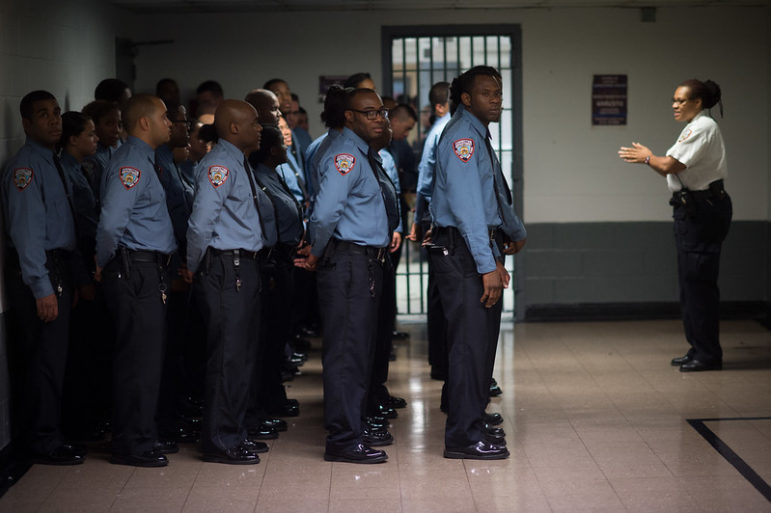The 7-day positivity rate in New York City jails was just over 19 percent on Sunday—down from nearly 37 percent just a week prior, the most recent data shows. But the humanitarian crisis at Rikers Island continues unabated, attorneys representing those behind bars testified Tuesday.

Michael Appleton/Mayoral Photography Office
Correction officers on Rikers Island in 2016.New York City ushered in a new year, a new mayor and a newly-appointed jails commissioner at the start of the month—but the humanitarian crisis at Rikers Island has continued unabated into the new administration, public defenders testified Tuesday, despite months of supposed reform efforts.
“We seem to only be moving backwards,” Julia Solomons, a social worker with legal aid group The Bronx Defenders, testified Tuesday at the first meeting of 2022 held by the Board of Correction (BOC), the city’s jails watchdog agency.
She and other attorneys representing people incarcerated at the troubled island jail complex shared stories of unchecked violence, unmanned security posts, insufficient food, cells littered with feces, freezing conditions and little access to recreation time. Their clients have gone without needed medication or access to doctors and mental health care professionals, they said; one incarcerated person told a visiting city councilmember they were forced to wait more than two weeks to get broken bones put in a cast.
More than 200 men incarcerated at one facility have gone on a hunger strike to protest the inhumane conditions, according to Christopher Boyle of New York County Defender Services.
“Our clients in custody are beginning this year with fear, anxiety and ongoing denial of their basic human rights,” Solomons said. “When the department says they’re committed to providing people with these services, its very hard to believe them.”
The chaos has been exacerbated by a recent surge in COVID-19 cases at Rikers, fueled by the omicron variant. The 7-day positivity rate in New York City jails was just over 19 percent on Sunday—down from nearly 37 percent just a week prior, the most recent data shows, but still starkly higher than what it was at the start of December.
The uptick prompted the Department of Correction (DOC) to suspend in-person visits on Dec. 22, and renewed calls for the city to lower its jails population to limit crowding. City jails housed 5,405 people as of Jan. 3, according to the BOC, up from a historic low of 3,832 in April 2020.
Ongoing DOC staffing dysfunction continues, officials testified Tuesday, with thousands of correction staffers—who have unlimited sick leave under city rules—failing to show up for work each day. DOC officials said that some 2,317 staff members were currently out sick, in addition to another 1,000 on indefinite leave, accounting for approximately 30 percent of the agency’s headcount.
“The morale of our staff is at an all-time low,” Louis A. Molina, the new DOC commissioner who took over the post on Jan. 1, told BOC members. “I strongly believe in criminal justice reform,” he assured the board, saying he is looking for “ways to implement changes that mutually benefit officers, our civilian staff and the people in custody.”
But Molina has been criticized during his first week on the job for replacing a much-respected DOC investigator and for reversing a sick leave policy, instituted under Mayor Bill de Blasio, that required staffers to show proof of illness if they missed more than one day of work (the union that represents correction officers said the previous policy had been overly punitive to COs, The Queens Eagle reported).
“The agency has taken a variety of steps, employed a variety of strategies to address our staffing shortages, and with the new commissioner’s plan we will be revisiting those and looking for other strategies to help address and tackle our staffing challenges,” Asim Rehman, general counsel for DOC, told Board of Correction members.
“You don’t have an officer shortage. You have a shortage of officers showing up,” BOC member Bobby Cohen shot back.
Another major point of contention is the DOC’s continued use of punitive segregation—better known as solitary confinement—a practice that was supposed to end by Nov. 1 and be replaced with a new disciplinary system, but which has continued under the use of emergency executive orders instituted by both Mayor Bill de Blasio and new Mayor Eric Adams, who has spoken out in support of the practice as a means for curbing violence behind bars.
Molina told the BOC Tuesday that implementing the new system intended to replace punitive segregation is a “top priority” for the department, but that they weren’t ready to move forward on it yet. “This is my 11th day in office and I just need a little more time,” he said.
DOC officials said Tuesday that eight incarcerated people were currently being held in punitive segregation. But public defenders and lawmakers say many more are being subjected to “Enhanced Supervision Housing“—a practice used to separate those accused of violating jail rules but which officials insist is not the same as solitary.
Those being held in ESH are supposed to get seven hours of time outside their cell per day, but attorneys and those who’ve visited Rikers say that isn’t happening.
“I met people on ESH who said they had not seen another person or sunlight in several days. They were going maybe every five days in between showers,” said City Councilmember Tiffany Caban, who visited Rikers last week as part of an oversight visit to the jail complex, where she says she witnessed “profoundly troubling” conditions. (COBA, the union that represents correction officers, claims the councilmember’s description of her visit amounts to a “litany of lies.”)
“There was no difference in the out-of-cell time and abysmally inadequate access to medical care,” Caban told the BOC. “These conditions are torture, plan and simple.”







